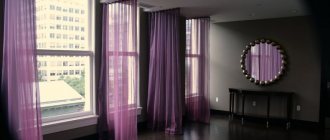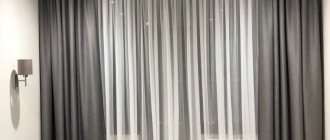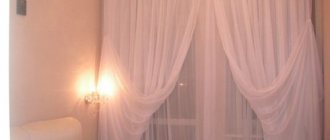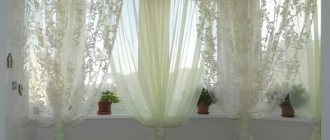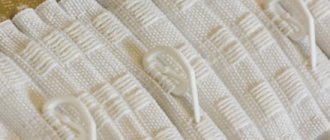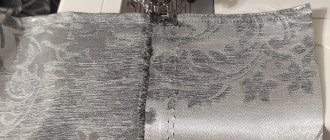Selecting and purchasing ready-made curtains for a window or doorway is often complicated by the fact that it is not always possible to purchase the option of the right size. If the shade and pattern of the curtains are ideal for the interior of the room, but the length is too long, you can cut the product to the required parameters. For this, basic shortening skills will be sufficient. Using simple methods will help you properly hem curtains made of thick or thin material.
Hemming rules
The lengths of finished products may differ for windows located in the same room, and even for different sides of the same opening. Therefore, you should measure all possible values and take the average. This is especially important when the length of the curtains is selected to the floor or exactly under the window. The differences in this case become clearly visible.
The following tips will help you hem curtains and tulle correctly:
- Materials, especially those containing natural fibers, are prone to shrinkage. Therefore, before starting work, it is advisable to wash new curtains and then iron them, following the recommended mode for a certain type of fabric.
- It is advisable to let heavy curtains hang on the curtain for 2-3 days to finalize the length, since the fabric may stretch.
- It is convenient to measure the length on a hanging curtain: secure the selected length with pins on both sides, and then pin marks on the removed ones every 10-15 cm.
- You can measure the distance from the cornice to the selected level using a tape measure, and then calculate the difference between the actual and desired length of the canvas, mark it with pins or draw a marking.
- First you need to iron the fold, this will help to cut the fabric evenly. You can only tear fabric made from natural fibers: calico, chintz, cotton.
The width of the hem of the bottom edge is determined according to the situation. There are no strict recommendations on this matter. Making a large hem is more practical, since you won’t need to trim the curtain and there will be a supply of fabric in case the curtain needs to be lengthened. Wide hems look good decoratively and are suitable for long models of medium density, as well as weighting short curtains.
Application of curtain tape
It is easy to slightly reduce the length of the curtain fabric using a special curtain tape.
Curtain tape is a special braid with two rows of string passed through it. It is designed to assemble the fabric into beautiful folds.
The use of curtain tape allows you to secure the curtain to:
- hooks;
- eyelets;
- string cornice;
- pipe.
If such fastening is planned, it is reasonable to hem the curtain with tape at the top.
Operating procedure.
- Take all measurements and mark the hem location with a line.
- Fold the fabric, secure with pins or iron.
- Carefully pin the braid to the fold.
- Sew the braid using two machine and hand stitches. The seams are laid above and below the ropes for assembling the fabric.
The use of curtain tape requires a small hem width. The excess will have to be cut off; a hem that is too thick will not allow the fabric to be gathered into beautiful folds.
How to trim tulle
Silk, chiffon or organza slide and shift during work, so it can be difficult not only to trim, but even to accurately mark the fabric. For even cutting, some needlewomen use simple tricks.
Pulling out the cross thread
To create a straight edge line, you can use the weft as a guide, that is, a transverse thread running exactly horizontally from one edge of the fabric to the other. Pulling it out will make the line of the future incision visible.
We work according to the following scheme:
- measure the required length along the edge;
- mark with chalk;
- make a small cut along the mark;
- pull out the cross thread;
- cut along the resulting “path”.
Tissue incision
If the material is very thin and capricious, it is impossible to pull out the thread, there are relief patterns on the canvas, as well as a complex interweaving of threads, then you can use the incision method.
This method will help you cut the tulle evenly:
- Carefully lay out the fabric on a wide, flat surface of such a size that the entire length of the curtain fits and folded in half along the width.
- Fold the material in half widthwise, carefully aligning the edges.
- Smooth out the product and secure the layers along its top and side edges with pins.
- Measure the length on both sides and make small cuts.
- Fold in half again, combine and secure the layers.
- Measure the length on both sides and make cuts.
- Depending on the width of the canvas, repeat or complete the procedure (there should be no more than 20 cm between cuts).
- Unfold and draw a line along the resulting marks, smoothing and pressing the fabric with a ruler, or immediately cut with large tailor's scissors.
Useful tips
It’s easy to hem curtains with your own hands by choosing one of the above methods. By being creative, you can solve the problem without a sewing machine.
Regardless of the chosen curtain folding method, several useful recommendations will help you cope with the work.
- For sewing work, be sure to select a needle and thread of the appropriate thickness.
- When making a machine seam, you must remove the pins from the fabric in a timely manner so as not to damage the machine.
- It is convenient to cut the fabric on the floor. When working with sliding materials, it is convenient to place a chintz fabric underneath.
- Seams must be done carefully, without pulling the fabric at the edges.
Binding methods
After cutting the fabric to the desired length, you will need to trim the edge. There are different ways to do this.
Standard seam
The bottom of the curtain can be hemmed with a straight stitch, having first made one or two folds.
The first option is used if the edge will not crumble in the future. The edge can be finished with a zigzag stitch or an overlock stitch. Suitable for curtains made of heavy fabrics or those with lining.
Straight stitching is done on a sewing machine. If the work is done manually, then a blind seam is used.
Progress:
- mark the border with a basting or iron the fold;
- choose the sewing thread and stitch length depending on the type of fabric and decorative design;
- sew the fold from the wrong side in a straight line, retreating a few millimeters from its edge.
Two-line filing method:
- fold the fabric to the wrong side according to the width of the sewing machine foot;
- tuck the fabric under the foot and make sure that the fabric lies flat and does not go beyond;
- press the hem and start sewing;
- as you work, gradually bend the fabric to the size of the foot;
- when the seam is stitched, cut the thread and return to the beginning of the line;
- we bend the fabric so that the previously made seam runs exactly along the edge;
- We bend the fabric, perform the second line and monitor the position of the first.
This seam is also called “Moscow”. A hem made using this method looks very neat.
A standard straight seam can also be used as a decorative one.
To complete the work you will need:
- Make two parallel lines.
- Choose special decorative threads so that they contrast in color with the main one.
- Try it first on a piece of cloth. You should fix the seam at the beginning and end of the stitch, making 3-4 stitches in the forward and then reverse direction.
Edging
When the texture of the curtain material has a significant volume or a shaped cut is processed, for example, a rounded one, turning is used. To do this, take ready-made bias tape of the desired color or make it yourself. When processing the edge in this way, the product should be shortened to the desired length without any allowances.
You need to sharpen it as follows:
- Stitch the binding along the bottom of the product and align the right sides.
- Unscrew and iron the tape to the wrong side.
- Hem the binding from the wrong side using a blind seam or hand stitches.
Adhesive tape
Using a glued hem is the fastest way to finish an edge.
You just need to take a few simple steps:
- Iron the hem.
- Place fusible tape under the wrapped fabric so that it does not come out.
- Iron at medium heat.
When using adhesive tape on thin fabrics, you need to be very careful. If the recommended temperature is exceeded, melted glue may bleed onto the front side of the product.
For wide hems, you can use two rows of tape.
Assembling with a “forward needle” seam
The “forward needle” seam is most often done manually. The advantage of this method is that you don't have to remove the long curtains from the window. The craftsmen also make stitches on a sewing machine, setting the maximum step width.
At the bottom of the product, mark the expected number of gathers, retreating about 5 cm on the sides. Next, determine the height of the folds, marking the seam with a vertical line. Use hand stitches to sew along the basting, tying knots at the top and bottom (there is no need to sew them to the curtain), and then pull the threads. You should get folds that are carefully aligned with your hands and secured from the inside out.
The “needle forward” method is recommended for light and smooth fabrics. Hand stitches simply will not be able to hold heavy material or the folds will be difficult to gather
Wash the product carefully so that the seams do not unravel.
Processing side cuts
If the side edges need processing, then it is better to do a double hem. The edge of the cut is bent by 1.5-2 cm and secured with a straight stitch or a hidden seam. Given the variety of materials, the bend size may vary, either increasing or decreasing.
The procedure was described earlier.
The difficulty of hemming along the grain thread lies in the possible stretching of the fabric. The layer underneath the fold tends to shrink and move when stitched. Therefore, while working, you need to monitor this and adjust the position of the layers in time, as well as slightly stretch the bottom sheet. Fixing the folds along the entire length with pins helps to simplify the work.
The sides can also be finished with edging.
Gusset
Additional attractiveness can be given to finished curtains by using a hidden diagonal seam to finish the corners. The method of its implementation is complex, but it looks very good on any rectangular products.
Procedure: Fold and iron the fabric 1-1.5 cm from the bottom and sides inside out. In the same way, we make the second hem, selecting the width that we plan to hem.
We unfold the second hem and make a corner diagonally with the front part of the fabric inward. We combine the edges and secure with a pin or needle along the line of the second fold closer to the corner.
Mark a 45 degree bevel to the fold marked with a pin, starting from the point at which the fold begins and towards the edge. We sew the corner along the resulting line and, stepping back from the seam 1 cm, cut off the corner.
We turn the product inside out and sew the folds along the contour. Iron the bend.
The video below details the diagonal blindstitch process.
Using a sewing machine
Using a sewing machine can significantly speed up work. Correctly hemming curtains using a machine is not difficult if you follow a few rules.
- The thickness of the needle and thread is selected in accordance with the thickness of the fabric. Using a thick needle can lead to unpleasant consequences in the form of a sloppy seam.
- The stitch pitch is selected within 0.5-0.7 cm.
- If the fabric frays noticeably, you will need to overcast the edge additionally.
Operating procedure.
- Take measurements carefully and mark the hem line.
- Fold the material, securing it with pins.
- Sew the seam using a machine without pulling the fabric.
For work, both straight and zigzag seams are used.
How to process tulle and organza
The edge of the tulle can be processed in similar ways: in a hem with one or two lines, edging or using an adhesive base. Although lightweight fabrics have their own characteristics.
For chiffon, organza or muslin, the edge can be successfully processed with a zigzag. This edge is thin and almost invisible.
To do this, a small fold of the fabric is made and a zigzag stitch with a medium pitch is used along the very edge. If there are any protruding threads or areas of unstitched fabric, they are cut off with sharp scissors.
For mesh or tulle curtains with a voluminous pattern, it is better to use bias tape edging.
How to shorten curtains or tulle without cutting
Sometimes the elongated size of the curtain is not a problem. You can shorten curtains or tulle without cutting it, but by draping the fabric into horizontal folds. There are several ways to do this.
Using needle and thread assembly
This method involves hand-assembling the candy using a needle-forward stitch.
It is most convenient to work on hanging curtains:
- Mark the desired number of gathers along the bottom edge (for the first and last, retreat 3-5 cm from the sides).
- Measure the height of the drapery and mark the future seam with straight vertical lines.
- Hang the curtain on the cornice and straighten the fabric widthwise.
- Sew the seams along the intended line, tie the end of each thread with a knot without attaching it to the material.
- Pull all the threads into the folds and fasten on the wrong side.
- Straighten the drapery.
This method is simple and fast, but is not suitable for heavy fabrics, and when washed, the “design” may become damaged and require repair.
You can replace the “forward needle” seam with a machine stitch with the widest stitch possible. By first fixing the threads on one side and carefully pulling the top or bottom on the other side, you can form the desired folds.
Scallop folds
Scalloped folds add pomp and solemnity to the curtains. Interior designers use three main ways to organize horizontal draperies.
London. When raised, the curtain forms two folds closer to the edge; when unfolded, a flat surface is obtained.
French. They may or may not be liftable. In any case, scallop folds are formed over the entire surface in several rows at equal distances from each other, which do not change their structure when rising.
Austrian. Scallop folds are formed only along the bottom of the curtain.
The following materials can be used to form scallops.
- Regular curtain tape. It is sewn by machine from the wrong side according to pre-made markings. Assemble and secure the ends. When creating French curtains, scallops are first formed by basting, and then the ribbon is attached. This option is suitable for static curtains. There are transparent tapes for thin tulles.
- Curtain tape with special rings is used for lifting curtains. A cord is inserted into the sewn tape, secured along the lower edge, and the upper ends, through hooks or rings installed on the cornice, are brought out to one side of the window.
Using curtain magnets
The fastest way to assemble a curtain is with curtain magnets. This simple accessory does not require any sewing skills at all. Each mount consists of two decorative magnets connected to each other by fabric or cord. The magnets are fastened together at the required distance, forming an assembly.
Let's look at the material
To process the top edge, you need to hem the curtain to the curtain tape with fasteners. Today there are quite a few varieties of them. In addition to the material of manufacture (transparent or white), the tape for hemming curtains has a number of characteristics:
- The width and number of rows for fastening (loops for hooks). This is convenient, since the fastening strips located in parallel, with a difference of several centimeters, make it possible to additionally adjust the length of the finished hemmed product.
- Depending on the number of gathering threads, a pattern of folds is formed in the upper part of the curtain, on the opposite side of the tape.
- Factor and type of assembly. Using ribbons, you can adjust the richness of the drapery, while the width of the curtain can be reduced from 1.5 to 3 times.
In the upper part of the curtain, with the help of tape, folds can be formed like an accordion, in a checkerboard pattern, there is a bow type of assembly, radial, etc.
General recommendations
When sewing any product, many nuances arise.
It is useful to pay attention to a few more little things:
- Remove the pins securing the product before stitching. If a metal object accidentally gets under the presser foot, it can damage both the fabric and the sewing machine.
- Needles for basting or hand stitching need to be the correct size. Too thick specimens may leave noticeable marks after removal of the temporary sutures.
- To prevent distortion of seams that are too long, you can use non-woven tape.
- Carrying out a preventive inspection of your sewing machine will help save time. A simple needle change will make it easier to sew thick materials that require sharp needles. Lubricating the chassis and adjusting the thread tension will allow you to enjoy your work.
- Spread several layers of thick cotton fabric on the cutting table. If necessary, you can pin the product to it so that it does not move or slide on the table.
Machine washing occurs in several simple steps:
Remove the curtains from the window. Remove the clips and rings from the curtains, soak separately in soapy water for 60-90 minutes, then rinse under running water and dry thoroughly. You need to wipe dry, especially metal parts, so that there are no streaks left on them.
Also pay attention to details made from other materials - after all, dust will settle on wet fasteners and they will quickly lose their appearance.
IMPORTANT! Before washing, test curtains for color fastness. To do this, dilute a little of the product you are going to wash with in water and drop it on the curtains
Wait a couple of minutes, then rinse off the product and let the curtains dry. If there are no traces left at the point of contact with the product, you can safely proceed to washing.
Load the curtains into the machine. Select a mode with a temperature of up to 40C and a spin speed of no more than 700 rpm (preferably less). Wash the curtains. Immediately after washing, return the curtains to the window so that they hang down - otherwise the fabric may wrinkle.
IMPORTANT! It is best to wash blackout curtains with liquid detergents, as they are more delicate to the fabric and color. IMPORTANT! Be sure to first wash the window and cornice, and only then hang the washed curtains - otherwise they will collect dirt and dust


